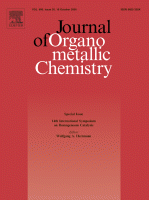







|
|
|
Journal
Publications |
|
Selectivity for the methoxycarbonylation
of ethylene versus CO-ethylene copolymerization with catalysts based on
C4-bridged bidentate phosphines and phospholes.
Simon Doherty, Edward G. Robins, Julian G.
Knight, Colin R. Newman, Barrie Rhodes, Paul A. Champkin, and William
Clegg, J. Organomet. Chem., 2001, 640, 182. |
|
Abstract: The C4-bridged
phospholes
11,12-bis(2,3,4,5-tetramethylphospholylmethyl)-9,10-dihydro-9,10-ethano-anthracene
(cis, 4a; trans, 4b) and
diphosphines
11,12-bis(diphenylphosphinomethyl)-9,10-dihydro-9,10-ethano-anthracene (cis,
5a; trans, 5b) and their
corresponding palladium complexes [(P---P)PdCl2] (6a–d)
have been prepared and characterized. Single-crystal X-ray analyses of
6a–d have been undertaken and they
reveal that 4a and b and 5a
and b coordinate in a bidentate manner forming seven-membered
chelate rings with natural bite angles between 98.62 and 100.30°. The
palladium-catalyzed carbonylation of ethylene has been studied using
4a and b and 5a and
b. Catalyst mixtures generated from 4a
and b, palladium acetate and methanesulfonic acid are
selective for the copolymerization of ethylene with carbon monoxide,
generating low molecular weight polymers. Surprisingly, the activity of
catalyst systems based on cis-(4a) is markedly
higher than that based on its trans-isomer, 4b.
The marked influence of the nature of the four-carbon tether is
highlighted by comparative catalyst testing with
[{1,4-bis(2,3,4,5-tetramethylphospholyl)butane}Pd(OAc)2],
which rapidly decomposes under the conditions used for copolymerization.
In contrast, under identical conditions catalyst mixtures formed from
5a and b show a marked dependence of
the selectivity on the stereochemistry of the ethano-anthracene tether,
the former generating a low molecular weight copolymer while the latter
generate mainly methyl propanoate. Interestingly, polyketone generated
from catalysts based on bisphosphole 4a has a markedly
higher average molecular weight than that formed using its
diphenylphosphino counterpart, 5a |
|



